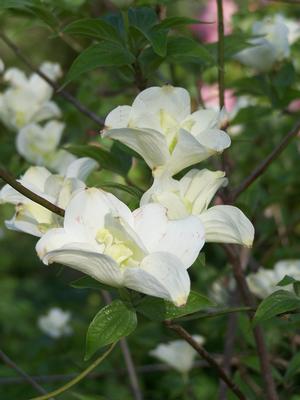Part VI: Trees for Food and Cover... and More!
Smaller ornamental trees double their value in opportunities for birds. The tree dogwoods are as important as are their smaller growing shrub cousins. There is a beautiful variegated giant dogwood, Cornus contraversa ‘Variegata’ which glows in open shade. The pagoda dogwood, Cornus alternifolia, draws at least 34 birds including Brown Thrasher, Wood Thrush and Downy Woodpecker. ‘Golden Showers’, a robust green and yellow-foliaged pagoda dogwood, with typical flowers and fruits is now available. Flowering dogwood (Cornus florida) has among its ranks white, pink and nearly red flowering forms. The double-flowered ‘Plena’ (see pic 1) is uncommon in trade and uncommonly beautiful in the landscape! The fruits are beloved by 36 bird species including Pileated Woodpecker, Evening Grosbeak, Northern Flicker and six species of Thrush. This beautiful tree has nearly disappeared from the wild in northeastern Connecticut. Therefore, planting one or several will help ensure its continuance. If situated as “understory” trees adjacent to larger growers, at woodland’s edge or in partly shaded sites in moisture retaining organic soils, they prosper keeping at bay the anthracnose and borers which have been their bane.
I have watched American Crows attack with gusto the late season sweet fruits of Chinese dogwood (Cornus kousa) stripping a small tree of its bounty in short order (see pic 2).
They feed upon carrion, too. But Crows, gifted with extraordinary intelligence, also strategically hunt as a group.
Maples, too, provide. The boxelder, Acer negundo, has gold-foliage forms and a pretty variegated offering called ‘Flamingo’ among its ranks. Evening Grosbeak and Purple Finch prefer the brown samara, the name for maple seed “helicopters”, in winter. Red-eyed Vireo nests in splendid sugar maples all the while Wrens, Warblers and Orioles pick insects off their emblematic five-lobed leaves.
During the summer of 2008 Robins took up housekeeping in a potted specimen of Japanese maple in one of our large greenhouses which during the growing season is a sales facility for hosta, ferns, woodland plants and, yes, Japanese maples. Had there been a request to purchase this gorgeous tree I would have accepted a down payment but would have refused to move it until the young had fledged; it would have been a necessary extension of humanity. But I was never put to the test as none were interested in this specimen tree that summer!
White-throated Sparrows (see pic 3) and Northern Flickers relish crabapples. These come in so many wonderful forms, upright, spreading and weeping, and also those with variably colored flowers, fruit and foliage. They are easy in the landscape, many with persistent apples as in the now classic ‘Donald Wyman’ with larger than usual red fruits lasting through the winter until the birds eat every last one. ‘Harvest Gold’ sports bright yellow apples. ‘Red Jade’, a very handsome weeping form, produces masses of typical pink buds opening to white and pink apple blossoms emitting a lovely light fragrance. The flowers fade but as in the proverbial “phoenix from the ashes” copious crops of glossy red fruits develop dangling late season.
American mountain ash (Sorbus americana) and, indeed, other non-native mountain ash species attract Brown Thrasher, Eastern Bluebird, Pine and Evening Grosbeaks, Gray Catbird, Cedar Waxwing and at least 14 more species. Scarlet and Summer Tanagers and another 45 species love the fruit of red mulberry, Morus rubra. The various species of hawthorn (Crataegus) with it glorious crops of autumn fruits draw 20 or more bird species, especially Cedar Waxwing.
Grasses in feeder, garden or field are a literal hay day for Juncos and Song, Chipping and Field Sparrows. Corn is a magnet for Nuthatches. Very fine grass and weed seeds such as groundsel will draw Mourning Doves. These handsome pigeon relatives breed in early spring. Like Robins they frequent a broad range of nesting sites choosing both evergreen and deciduous trees and sometimes lower-growing shrubs.
There are so many ornamental native and prairie grasses available to the home gardener. They look great with any of the late-season composites or daisy-flowered perennials which are naturals for color and textural relief. The multiple species of goldenrods (Solidago) look terrific with grasses and provide a feast for many sparrows and Goldfinches. Bird-attracting winterberry cultivars (Ilex verticillata) couple structure with fruit (see pic 4) for complementary texture to grasses.
And speaking of daisy flowers: black-eyed Susan (Rudbeckia), purple cone flowers (Echinacea), both annual and perennial sunflowers (Helianthus) and orange sunflowers (Heliopsis) draw Goldfinches, Titmice, Chickadees and Nuthatches. Cardinals eagerly crack sunflower seed to get at the tasty hearts. Thistles feed Goldfinches and Pine Siskins. Coincidentally, the morning after Dr. Craig mentioned that he was treated on a daily basis to Pine Siskins visiting his feeders in Putnam Heights in the hard winter of 2009 I spied the first I had ever seen at our feeders in Brooklyn. And since, they have returned regularly. Stay tuned.


